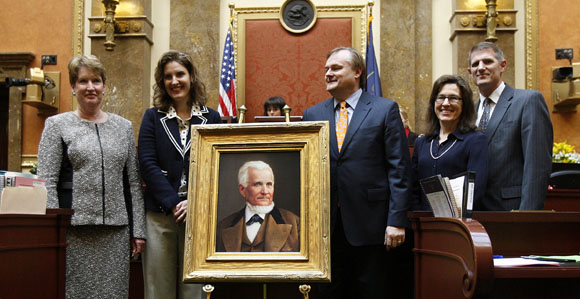John Taylor Portrait Presented to Utah House of Representatives
Contributed By By R. Scott Lloyd, Church News staff writer

Carol Sorenson Smith, left, great-great-granddaughter to John Taylor; Elizabeth Mower, great-great-great-granddaughter to John Taylor; Elizabeth's husband, Mike Mower; Jayne Corbett; and Ken Corbett, the artist.
Article Highlights
- Descendants of John Taylor presented the current Utah State Legislature with a portrait of President Taylor on February 4.
- President Taylor served as the speaker of the Utah Territory House of Representatives from 1857 to 1876, the second-longest term in state history.
- Legislators will display the picture in the Utah State Capitol along with several documents signed by President Taylor.
Related Links
Among the lesser-known attainments achieved by John Taylor, third President of the Church, was his role as the second-longest serving speaker of the Utah Territory House of Representatives, a term that extended from 1857 to 1876, after his election to that lawmaking body in 1853.
His service as speaker of the House was recognized February 4, as a portrait of President Taylor was presented to the present-day Utah House of Representatives as it met in session at the Utah State Capitol in Salt Lake City.
Making the presentation in a brief ceremony were descendants of President Taylor: Carol Sorenson Smith, third-great-granddaughter, and her daughter and son-in-law, Liz and Mike Mower. Also present for the dedication were the portrait artist Ken Corbett and his wife, Jayne.
Speaking to the legislators, Sister Smith gave some highlights from the life of President Taylor, noting that he was born in England and later immigrated to Canada, where he and his wife joined the Church, and then moved to Missouri and later Illinois.
“While living in Nauvoo, Illinois, John Taylor served as a city councilman, a chaplain, a colonel, a newspaper editor, a judge-advocate for the Nauvoo Legion, and as an LDS Apostle,” she said. “He was present in the Carthage Jail when the Mormon prophet, Joseph Smith, was martyred. [John] Taylor sustained serious injuries during the assault.”
She said he served a Church mission in England and then returned to Nauvoo, where he and fellow Apostle, Elder Parley P. Pratt, led a group of 1,500 pioneers to the valley of the Great Salt Lake.
She recounted that Elder Taylor applied for U.S. citizenship in 1849, the same year he was appointed associate judge in the provisional State of Deseret.
He was elected to the House in 1853, representing Great Salt Lake County, and then became speaker, succeeding W. W. Phelps, Jedediah M. Grant, and Hosea Stout.
Sister Smith listed some of the numerous actions the legislature took during his five terms as speaker, including asking the U.S. Congress to establish mail and telegraph service to Salt Lake City, establishing a territorial library, setting times and places for district courts, standardizing weights and measures, appointing a commissioner to the Great International Exhibition in Paris, establishing several Utah counties, requesting federal land for cities and towns, and, in 1861, unsuccessfully petitioning Congress for statehood.
Succeeding President Brigham Young, who died in 1877, as President of the Church, President Taylor directed colonization in Utah, Canada, and Mexico.
“John Taylor, an accomplished musician, colonizer, writer, editor, legislator, Church leader, and family man, passed away on July 25, 1887, in Kaysville, Utah,” Sister Smith said.
At the conclusion of the presentation, House Speaker Rebecca Lockhart indicated that a suitable location would be determined in the Capitol for hanging the portrait. She announced that some original documents signed by President Taylor while he was speaker would be displayed in a nearby room for the legislators to view.

